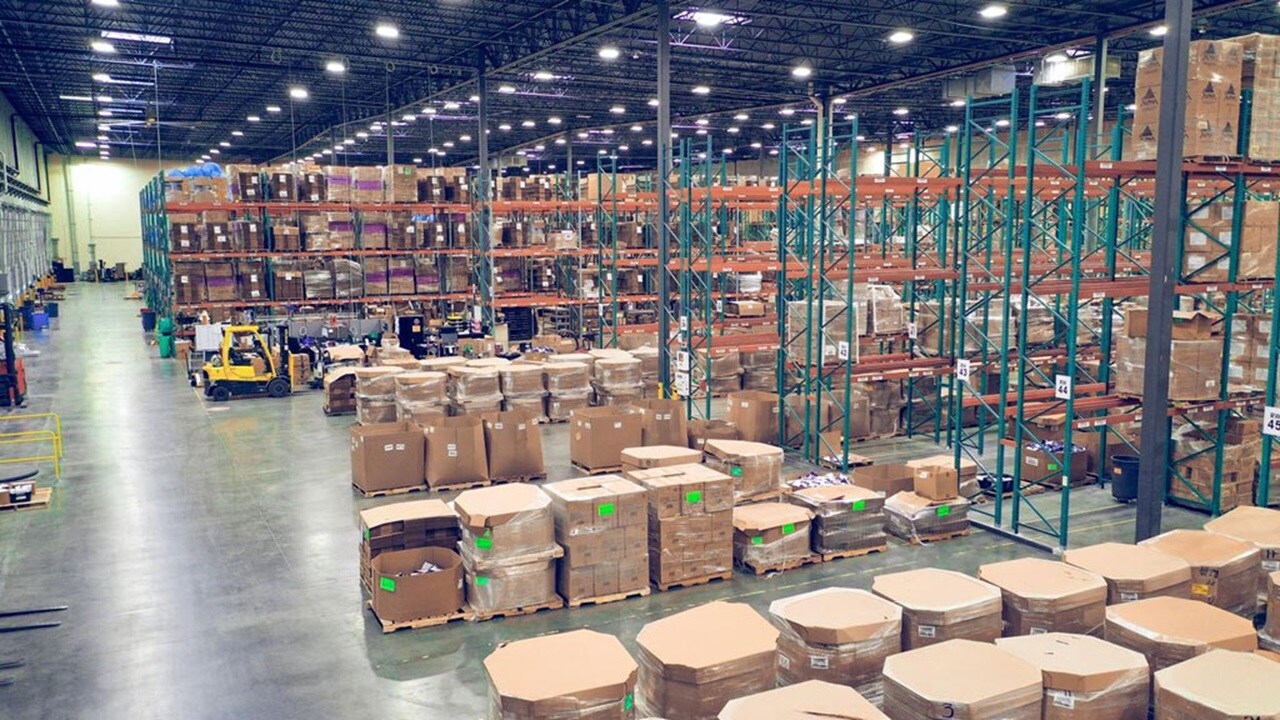The content in this article is to speak to trends and insights Maersk sees in the industry and not necessarily representing our position or strategy around automation and AI in the warehousing space across any particular region of the world.
Without a doubt, artificial intelligence (AI) is here to revolutionise the world, logistics included.
In the context of supply chain management, this transformation (also referred to as “platform change”) could transform the way we plan, execute, and optimise the movement of goods from one location to another. More specifically, by leveraging the power of artificial intelligence (AI) and machine learning (ML), businesses can gain:
- Real-time insights into their supply chain operations.
- Accurate forecasting of demand patterns.
- Optimised inventory levels.
- Reduced transportation costs.
- Improved customer service.
- High level strategy analysis and optimized financial reporting.
- Better security and risk management.
Cloud and artificial intelligence for integrated logistics
Supply chains are also becoming digitised in terms of how data is being created, stored, and analysed. Years of investment in the deployment of sensors, cameras, IoT devices, and integrations have helped to digitise the physical movement of goods and has significantly increased the volume of data created throughout supply chains. In addition, while data was traditionally stored in on-premises warehouses (that were difficult to access, integrate or innovate with), we now see the emergence of cloud-based systems. Soon, leveraging the latest cloud-based tech architectures will enable various use-cases of AI in supply chain management, enabling businesses to take advantage of integrated logistics offerings and seamlessly manage the flow of their cargo between sea, land, and air.
Upcoming uses of AI for supply chain management
Here below, are the areas in which the implementation of AI and machine learning will soon reshape processes and modus operandi:
- Fraud detection: These innovations can be used to detect and prevent fraudulent activities in the supply chain, such as theft, counterfeiting, and unauthorized access to sensitive data.
- Demand forecasting: These tools can help with predicting demand patterns more accurately by analysing historical sales data, market trends, weather, and possible disruptions. This can enable better inventory planning and reduce stock outs.
- Predictive maintenance: By monitoring equipment and assets in real-time, potential issues can be identified before they occur. This can help reduce downtime and maintenance costs, as well as improve overall equipment effectiveness. The concrete applications here are relevant for all assets owners optimising “up-time” such as warehouse owners, terminal operators, fleet managers, etc.
- Real-time supply chain monitoring and adjustment: AI can provide real-time visibility into the entire supply chain, from raw materials to finished products. This can help identify potential bottlenecks and delays, enabling companies to proactively take corrective actions. The digital twin technology (a virtual, realistic replica of a physical asset or system, like a truck, warehouse or supply chain) will help with both performance-improvement and strategic purposes. Digital twin simulations can be used to visualise the performance of supply chain operations, to manage potential disruptions, and to stress-test supply chain resilience by modelling scenarios such as changing distribution flows. This acquired visibility into supply chains will improve risk management, decision-making as well as customer experience.
- Warehouse and transportation automation: With the use of AI and ML, it is possible to automate and optimise warehouse and transportation operations. This includes software systems used for forecasting, inventory management and route planning, as well as automated assets like robots, picking arms, drones, forklifts, and trucks. This can help companies reduce costs and improve efficiency, while also improving their customer service levels. “This is a gamechanger” says Jannik Pedersen, Head of Strategic Insights at Maersk, adding “we currently see constrained autonomous vehicle (AV) applications at yards, warehouses, and terminals. However, we believe that starting from 2025 we will start see “hub-to-hub” AV applications on highway corridors changing trucking forever and leading to better logistic integrations”.
- Personalisation: AI can be used to generate personalised recommendations for customers based on their purchase history, business fundamentals (e.g., industry, size, and value chain) search history, and other data. This can help improve customer experience and increase sales, by predicting next best actions and/or optimization ideas.
- Autonomous processes: With the implementation of AI and AI agents (which are AI tools with the ability to autonomously perform consecutive AI tasks and can provide multiple outputs with just one input) whole work processes with multi source data input, and workflows that require inputs from those processes, can potentially run autonomously.
How will ChatGPT (and Auto-GPT) benefit logistics?
Open AI’s phenomenal ChatGPT program and similar generative AI models, such as AutoGPT and other AI Agents, can be used in logistics with the most impactful use cases around automating workflows and customer experience. As an example, ChatGPT has the ability to be used to develop chatbots that provide customers with real-time assistance, such as answering queries faster, providing order updates, and resolving complaints, exponentially reducing wait and response times. In the future, these systems will be further developed and will likely be able to resolve some of the data access and data rights concerns that exist today. The capabilities of these systems are developing exponentially, with increasingly accurate practical use cases that could facilitate problem solving and improve overall customer experience.
The future ahead
“Artificial intelligence has the potential to be the next fundamental technology shift in logistics, in the same way that the internet and mobile technology transformed the way we live and work” says Jannik Pedersen, Head of Strategic Insights at Maersk. Currently, there is a gold rush to build AI solutions and to leverage this technology to automate routine tasks, reduce costs, and improve efficiency. With the development of new technologies and algorithms, we can expect to see more advanced AI/ML applications in the logistics industry in the future, which will drive greater innovation and competitiveness. In fact, the whole category of supply chain software could become one of the next frontiers in cloud software. We see the opportunity for new categories of intelligence and application-layer supply chain SaaS companies to be built on top of these digital middleware layers. These categories could include:
- Digital twin simulation and holistic optimization models.
- Supplier/procurement intelligence and management.
- Decarbonization and circularity analytics.
- Inventory forecast and planning.
- Workflow automation and optimization tools.
- Other industry-specific digital infrastructure.
In conclusion, these AI applications and types will not only support logistics planners to improve their logistics costs, but also build resilience into supply chains through higher responsiveness and agility to real-time events or disruptions.
Note: this article has been completely written by a human.

Annex: Taxonomy of AI that can be used in logistics
- Rule-Based AI: Rule-based AI systems follow a set of predefined rules and decision-making criteria to make predictions and recommendations. For example, a rule-based system can be used to suggest a particular mode of transportation for a shipment based on weight and distance.
- Supervised learning AI: Supervised learning algorithms are trained on labelled data to make predictions on new data. For example, a supervised learning algorithm can be trained to predict demand for products, based on historical sales data.
- ETA predictions and customs throughput times: For example, one can build predictive models to classify weather a truck will be on time or not based on data from transport control towers that tracks live information on the location of trucks.
- Reinforcement learning AI: Reinforcement learning algorithms learn to make decisions based on feedback from the environment. For example, a reinforcement learning algorithm can be used to optimise the routing of delivery trucks to minimise transportation costs.
- Multi-source or multi-mode replenishment: When you have access to multiple sources of replenishment of your inventory, reinforcement learning can support the decision of how much to replenish from an affordable offshore supply and how much to source locally, at higher cost. Similarly, it can be used to combine multiple transport modes in parallel, where part of the shipment is shipped using a slower, but less carbon-emitting mode, and part is shipped using a more responsive mode.
- Omni-channel supply chains: When managing inventory for multiple channels, reinforcement learning can prescribe how much product should be stocked centrally to leverage inventory pooling, ensure fast delivery, and suggest from which warehouse or storefront orders should be filled from.
- Natural language processing AI: Natural language processing (NLP) algorithms are used to understand and analyse human language. For example, NLP algorithms can be used to analyse customer feedback and sentiment in supply chain management and logistics.
- Agent-Based AI: Agent-based AI systems generate prompt-based output, which is then further processed and integrated into autonomously generated tasks. These systems can perform tasks in the supply chain that require hypothesis generation, such as identifying future trends. For instance, by predicting demand in specific regions, an agent-based AI can autonomously suggest capacity acquisition strategies
Sign up to The Logistics Pulse newsletter
You did it, welcome onboard!
We're sorry, but there was a problem sending your contact request.
Please review the form fields and ensure all required information is provided correctly. If the issue persists, please contact our support team for further assistance.
Sign up to The Logistics Pulse newsletter
Receive our insights directly in your mailbox by signing up through this form and enter a world of truly integrated logistics. Get inspired by our selection of articles that help you navigate supply chains, understand industry trends, and shape your logistics strategy. You can unsubscribe anytime.













